AEG
 |
|
| Type | GmbH |
|---|---|
| Industry | Conglomerates |
| Founded | 1883 |
| Founder(s) | Emil Rathenau |
| Headquarters | Frankfurt am Main, Germany |
| Products | Communication Systems Power Generation Automation Lighting Medical technology Transportation and Automotive Water Technologies Home Appliances Fire Alarms IT Services |
| Revenue | |
| Operating income | |
| Net income | |
| Total assets | |
| Total equity | |
| Employees | 200,500 (2008) |
Allgemeine Elektricitäts-Gesellschaft (AEG) (literally General Electricity Company) is a German producer of electrical equipment founded in 1883 by Emil Rathenau.
AEG was the first to introduce a complete brand - logo, design and corporate identity - which was created by the architect/designer Peter Behrens.
In 1967 AEG joined with Telefunken creating AEG-Telefunken. In 1985 AEG was bought by Daimler-Benz, later being wholly integrated into DaimlerChrysler forming part of AdTranz. By 1997 the company no longer existed.
In 2005 Electrolux bought the brand name and now trades using the brand AEG-Electrolux. As of 2009 the AEG name is also licensed to various companies.
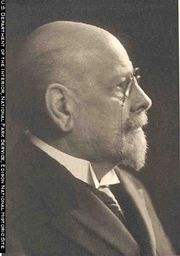
Contents |
History
Summary
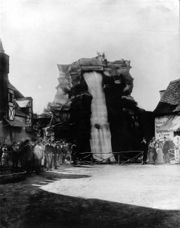
AEG was created in 1887 from the Deutsche Edison Gesellschaft (DEG), initially the company produced electrical equipment - light bulbs, motors and generators etc., it soon became involved in AC electrical tranmission systems. In 1907 Peter Behrens was appointed as artistic consultant to AEG, an event which brought about the creation of the worlds first corporate identity, with products and advertising sharing common design features - all linked to the company name AEG.[1]
The company expanded in the first half of the 20th Century and is credited with a number of firsts and inventions in the electrical engineering field. During the same period it entered the automobile and airplane markets. Electrical equipment for railways was also produced during this time - starting a long history of supplying the German railways with electrical equipment.
After the black period of the Second World War the company lost those businesses located in the eastern part of Germany. In 1967, after a merger, the company was renamed AEG Telefunken. The company experienced financial difficulties during the 1970s resulting in the sale of some of its assets; in 1983 the consumer electronics division was sold and the company re-took the name AEG. In 1985 the remainder of the company was acquired by Daimler-Benz; the parts that remained were primarily related to electric power distribution, and electric motor technology. Under Daimler Benz ownership the former AEG rump companies eventually become part of the newly named Adtranz in 1995. In 1996 AEG as a manufacturing company ceased to exist.
Time line - from foundation to 1940
The origins of the company can be traced to 1882, when Emil Rathenau who had acquired licences to use some of Thomas Edisons lamp patents in Germany.[chron 1] The Deutsche Edison Gesellschaft (DEG) (literal: German Edison Company) was founded in 1883 with the financial backing of various banks and private individuals, with Emil Rathenau as company director.[chron 2]
In 1884 the Munich born engineer Oskar von Miller (who later became the founder of the Deutsches Museum) joins the executive board. The same year the company enters negotiations with the Berlin Magistrat (the municipal body) to supply a large area from a central supply, which successfully result in the formation of the Städtische Elektricitäts-Werke AG zu Berlin (AGStEW)[2] (literal: City electricity works company (berlin)) on the 8th of May 1884 - this date is considered to be the birthday of the German electrical industry.[chron 3]
The original factory was located near Berlin Nordbahnhof (then named Stettin bahnhof). In 1887, the Company acquired land in the Berlin-Gesundbrunnen area on which the Weddingsche Maschinenfabrik (founded by Wilhelm Wedding) was previously located. In the same year, in addition to a restructuring and expansion of the production range the name AEG was adopted.[chron 4]
In 1887 Mikhail Dolivo-Dobrowolsky joined the company as chief engineer, later becoming vice-director. His work on rotary power, building on the work of Nikolai Tesla, led to the first practical application of an AC motor in the world.[chron 5]
In 1891 Miller and Dobrovolski succeeded in demonstrating the transmission of electrical power over a distance of 175 km (109 mi) from a hydro electric power plant in Lauffen am Neckar to Frankfurt, where it lit 1000 light bulbs and drove an artificial waterfall - at the International Electrotechnical Exhibition in Frankfurt am Main. This success marked one of beginnings of the general use of alternating current for electrification in Germany, and showed that distance transfer of electrical power could useful economically. Additionally, in the same year the Stadtbahn Halle/Saale (City railway Halle - Saale) is opened - being the first electric tram system (of notable size) in Germany[chron 6]
Tropp Paul began his work for the AEG 1889/90 until 1893, and Franz Schwechten designed the facades of the Acker- und Hussitenstraße 1894-95.
In 1894 the site of the former Berlin Viehmarktgasse (cattle market) was purchased. This had a siding connecting to the Berlin rail network produced, but there was no rail connection between the two plants - therefore in 1895 a link between the two plots was built as an underground railway in a specially designed tunnel of 270 meters in length. The tunnel was implemented by Siemens & Halske (S & H) (later to become Siemens) under the direction of C. Schwebel and Wilhelm Lauter - this is now the Spree tunnel Stralau - used by public transport.
In 1903 the competing radio companies of AEG with and of Siemens & Halske are merged forming a joint subsidiary company with the name Telefunken.[chron 7]
In 1907 the architect Peter Behrens became an artistic adviser.[chron 8] Responsible for the design of all products, advertising and architecture, he has since become considered as the world's first corporate designer.
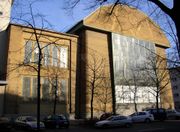
The activity of the company soon extended to all areas of electrical power engineering, in particular to electric lighting, electric power, electric railways, electro-chemical plants, as well as the construction of steam turbines, automobiles, cables and cable materials. In the first decades, the company had many factories in and around Berlin:
On the 20th June 1915 the founder, Emil Rathenau dies aged 77.[chron 9]
- Maschinenfabrik ( Dynamos, Electric motors, transformers)
- Apparatefabrik (arc lamps, switches, fuses, resistors, controls, starters, electrical measuring equipment)
- Kabelwerk (copper and metal works, rubber fabrication, insulator fabrication)
- Glühlampenfabriken (carbon-filament and metal thread light bulbs, Nernst lamps) - later to become part of Osram
- Turbinenfabrik (steam turbines) - famous as an example of industrial architecture
A number of other notable events involving AEG occurred in this period:
- 1900 - Invention of the hairdryer.
- 1901 - The Neue Automobil Gesellschaft (NAG) (literal: New Automotive Company) becomes part of AEG via the take over of Allgemeine Automobil-Gesellschaff[chron 10]
- 27 October 1903 - A three-phase AC AEG motor in a competition with Siemens & Halske achieves a speed of 210.2 km/h (131 mph) on the test track of the Königlich Preußische Militär-Eisenbahn (Royal Prussian military railway) between Marienfelde and Zossen. This world speed record for rail vehicles was held until 1931.[chron 7]
- 1904 - Merger of AEG with the Union-Elektricitäts-Gesellschaft (UEG) (literal: Union-electricity Company)
- 1910 - Entry into the aircraft building market.[chron 11]
- 1929 - AEG produces its first compressor driven fridges and temperature controlled irons.[chron 12]
- 1935 - Presentation of the world's first tape device Magnetophon K1 at the Internationale Funkausstellung Berlin (International Radio Exhibition) - Based on work by Eduard Schüller[chron 13]
- 1941 - AEG buys S & H (Siemens & Halske) shares in Telefunken and the company becomes a 100% subsidiary.
The Nazi era and World War II
Documents show that AEG donated 60,000 Reichsmarks to the Nazi party after the Secret Meeting of 20 February 1933 at which the twin goals of complete power and national rearmament were explained by Hitler.[3][4]
During World War II, an AEG factory near Riga used female slave labour.[5] AEG were also contracted for the production of electrical equipment at Auschwitz concentration camp.[6]
AEG used slave labour from Camp No. 36 at the new sub-camp of Auschwitz III called "Arbeitslager Blechhammer". Most of these would die in 1945 during the death marchs and finally in Buchenwald. [7]
1945 to 1970
In 1945, after the Second World War, the production in the factories in the western sectors of Berlin and Nuremberg, Stuttgart and Mulheim an der Ruhr resumed and further new works were erected, among others an Electric meter plant in Hameln.
The steam and electric locomotive plant in Hennigsdorf (Fabriken Hennigsdorf) became a Volkseigener Betrieb (VEB) (people owned enterprise) as the Lokomotivbau Elektrotechnische Werke (LEW) (literal: electric locomotive works). The cable plant (Draht-, Kabel- und Metallwerk Oberspree) and apparatus factory (Apparatefabrik Treptow) and other facilities also lay in East Germany and became Sowjetische Aktiengesellschaft (SAG) (Soviet joint stock companies). Over 90% of assets in Berlin lay in the Russian occupied zone and were lost.[8]
The headquarters for the non-expropriated parts of the company were moved first to Hamburg and then finally to Frankfurt am Main, the headquarters in Berlin having been destroyed.[8]
- 1950 - The new corporate headquarters are at the Friedensbrücke (Peace Bridge) in Frankfurt / Main. The number of employees in the Group rose from 20,900 in September 1948 to 55,400 persons in September 1957. In the same year the turnover exceeded one billion DM for the first time, however the high level of investment in the rebuilding of the company (1948 to 1956 over 500 million DM) placed a considerable strain on the balance sheet.
- 1958 The slogan "Aus Erfahrung Gut" is introduced - resulting in vernacular modifications such as "Auspacken, Einschalten, Geht nicht" - (unpacking, switching on, does not work) or "Alles Ein Gammel" (Everything is 'gammy')
- 1962 The Group has 127,000 employees and generates annual sales of 3.1 billion DM. In Springe a new factory is opened in February 1962 a new factory for the production of fluid control units with 200 employees.
- 1962 Walter Bruch at Telefunken in Hannover develops PAL TV color.
- 1966 The largest industrial space in Europe is created (175 m long, 45 meters wide and 26 meters high) for the construction using cranes of engines and generators with weights up to 400 tonnes. Robert Kennedy attends the opening.
- 1 January 1967 - Merger with Telefunken creates AEG-Telefunken, headquartered in Frankfurt am Main.
1970s onwards

- In 1970 AEG-Telefunken has 178,000 employees worldwide and is the twelfth largest electrical company in the world. However the company is burdened by, among other things, ultimately unsuccessful projects, such as the construction of an automated baggage conveyor system at Frankfurt Airport and its entrance into the nuclear power plants building business. The companies' line of Boiling water reactors were not successful on the market. In particular, the nuclear power plant at Würgassen, the commissioning of which was delayed by several years due to a number of technical problems cost AEG hundreds of millions of DM.
- In 1972 The company stock provided a dividend from the last time. The entertainment arm (Telefunken Fernseh und Rundfunk GmbH) headquartered in Hanover is sold outsourced. Next is computer technology: the mainframe business (TR 4, TR 10, TR 440) (a partnership under the name Telefunken Computer GmbH with the company Nixdorf is sold to Siemens. The process computer (TR 84, TR 86, AEG 60-10, AEG 80-20, AEG 80-60) continues as Geschäftsbereich Automatisierungstechnik (after 1980 as ATM Computer GmbH)
- 1975 The former Telefunken building at Berlin Ernst-Reuter-Platz is sold. The building was previously rented to the Technical University of Berlin
- 1976 To circumvent the equal participation of employees in the Supervisory Board, Dr. Walter Cipa (Dipl.-Geol.) (AEG boss from 1976 to 1980) creates four further companies are created as wholly owned joint stock companies in addition to the two household appliance companies: (The numbers in brackets refer to percentage of turnover in 1980)
- AEG-Telefunken Anlagentechnik AG (37 %)
- AEG-Telefunken Serienprodukte AG (16 %)
- AEG-Telefunken Kommunikationstechnik AG (6 %)
- Olympia Werke AG (business office technology, 7%)
- AEG-Hausgeräte GmbH (22 %)
- Telefunken Fernseh und Rundfunk GmbH (12%)
- In 1979 AEG-Telefunken Aktiengesellschaft is renamed Allgemeine Elektricitäts-Gesellschaft ('AEG)- as first used in 1887
- 1980 Heinz Dürr becomes board Chairman (until 1990)
- 1982 On the 9th of August a restructuring plan, with federal guarantees of 600 million DM and new bank loans of 275 million DM provided, falls apart at the first disagreement between the banks, a banking consortium gives an administrative loan with the AEG Group until June 1983 of DM 1.1 billion of which 700 million is immediately available with the further DM 400 million available after promise of a guarantee by the federal government. Not only is AEG-Telefunken AG affected, but also its subsidiaries Küppersbusch AG in Gelsenkirchen, Hermann Zanker Maschinenfabrik GmbH & Co. KG in Tübingen and Carl Neff GmbH in Bretten. The Alno-Möbelwerke GmbH & Co. KG in Pfullendorf was taken over by previous minority shareholders, and separated from the group. Additionally suppliers of AEG were affected and had to file for bankruptcy - including Becher & Co. Möbelfabriken KG in Bühlertann with lack of continuity of company policy a factor. The site at Brunnenstraße in the former Berlin district of Wedding was also sold, as were the firms AEG-Fabrik Essen and Bauknecht.
- 1983/84 the Consumer electronics division (Telefunken television and broadcasting GmbH) is sold to the French group Thomson-Brandt.
- 1985 'AEG is taken over by Daimler-Benz AG. Daimler-Benz executive Edzard Reuter (from 1987 Daimler CEO), decided that two companies should form an "integrated technology group" with beneficial synergy.
- 1988 On its 60th year anniversary the AEG-Forschungsinstituts (AEG Research Institute) creates the Carl-Ramsauer Prize for scientific/technical dissertations.
- 1990 AEG Westinghouse Transportation Systems GmbH is formed in association with Westinghouse Transportation Systems Inc.
- 1992 Merger (or re-uniting) of the railway business with the Lokomotivbau Elektrotechnische Werke (LEW) in Hennigsdorf, resulting in the formation of AEG Schienenfahrzeuge GmbH (AEG locomotives)
- 1992 The Swedish company Atlas Copco acquires AEG Power Tools Ltd.
- 1994 sale of the Automation division to Schneider Electric and of AEG Hausgeräte AG to Electrolux.
- 1995 AEG Schienenfahrzeuge GmbH becomes part of ABB Daimler-Benz Transportation (Adtranz) (subsequently becoming part of Bombardier Transportation in 2001).
- 1996 The Annual General Meeting of Daimler-Benz AG chaired by Juergen Schrempp decides upon the dissolution of the lossmaking group.
- 1996 GEC ALSTHOM acquires AEG Power T&D business
- September 1996 The company is deleted from the commercial register.
Products
Locomotives and railway technology
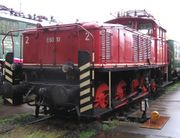
AEG played an important role in the history of the German railways - the company was involved on the development and manufacture of the electrical parts of almost all German electric locomotive series and contributed to the introduction of electrical power in Germany railways.
Additionally many steam locomotives were made in AEG factories. In 1931 the company transferred the locomotive production to the AEG-Borsig works (Borsig Lokomotiv-Werke GmbH) from the plant in Hennigsdorf. In 1948 the plant became VEB Lokomotivbau Elektrotechnische Werke. In addition to numerous electric locomotives produced for the DR steam locomotive production continued until 1954.
When the Federal Republic of Germany began implementing AC propulsion systems AEG found itself in competition with BBC. The prototype DB Class E320 was built with Krupp as dual voltage (15 kV and 25 kV AC) test machine, the technology ultimately leading to locomotives such as DB Class 120 and ICE 1.
Only after German reunification and the adoption of the LEW plant in Hennigsdorf did AEG's name return to whole locomotive manufacturing, but only for a short time. "AEG locomotives GmbH " became part of ABB Daimler-Benz Transportation (later ADtranz) and currently the technology developed in the past, in part, now enables Bombardier Transportation to build the very successful TRAXX series of locomotives.
Aircraft
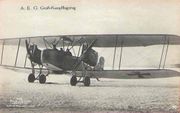
- see also List of AEG aircraft types
Additionally, AEG manufactured a range of aircraft from 1910 to 1918.
The first aircraft in 1912 was of wooden construction and modeled after the biplane of the Wright brothers. It had a wingspan of 17.5 m, powered by an eight-cylinder engine producing 75 hp; unladen weight was 850 kg and could attain a speed of 65 km / h. From 1912, the construction of airplanes in mixed wood and steel tube construction with fabric covering.
One of the planes designed and built was the R-plane (the R was an abbreviation of "Riesenflugzeug" (giant aircraft)) AEG R.I. This aircraft was powered by four 260 h.p. Mercedes D.IVa engines linked to a combination leather cone and dog clutch. The first flight tests were satisfactory, but on September 3, 1918 the R.I broke up in the air killing its seven crewmen.
During the Second World War AEG produced machines for reconnaissance purposes, including a helicopter platform driven by an AC motor, the power supply was carried by three cables from the ground, this was a tethered craft - the machine could not fly freely. The machine reached an altitude of 300 m.
Cars
AEG bought Kühlstein in 1902, founding the division Neue Automobil Gesellschaft (New Automobile Company), to make cars. AEG withdrew from car production in 1908.[9]
Models produced include:
- AAG (1900 automobile)[10]
- NAG Typ A
- NAG Typ B
- NAG Typ B2
Film projectors
AEG also produced for a long period a series of film projectors:[11]
- Stillstandsmaschine 1919 Projektor 35 mm
- Theatermaschine 1920 Projektor 35 mm
- Triumphator I–III 1924–1935 Projektor 35 mm ACR 0710
- Successor (Lehrmeister) 1925–1935 Projektor 35 mm
- Kofferkino 1927 encased Projektor 35 mm
- Lehrmeister 1929 Projektor 35 mm ACR 0709 (Leitz)
- Mechau Modell 4 1929–1934 Projektor 35 mm
- Euro K 1938–42 Projektor 35 mm
- Euro M 1936 Projektor 35 mm
- Euro G 1938 Projektor 35 mm, Interlock-Version (G-MB)
- Euro M2 1939–1944 Projektor 35 mm
The AEG brand name post dissolution
After the breakup and dissolution of the company the brand name was still seen to have a value. Electrolux acquired the brand and the name is also licensed to various companies:[12]
- AEG Electrolux - white goods; washing machines, dishwashers, ovens, fridges etc.
- ITM Technology AG produces consumer electronics and telecommunication (mobile phone, home phone etc) equipment under the AEG name.[13][14]
- AEG Elektrowerkzeuge produces hand power tools.[15]
- AEG Haustechnik produces home heating and climate control control (humidifiers, airconditioners) products [16]
- AEG Industrial engineering produces electrical power equipment, including generators up to 55MW, control gear and switchgear, electrical motors, transformers etc. as well as high power inverters and DC supplies for industrial use.[17]
- AEG SVS Schweiss-Technik - manufacturer resistance welding machines and equipment [18]
- AEG Elektrofotografie - Produces photoconductors - specifically photoconductor drums for printing applications (e.g. laser printer/photocopier) [19]
- AEG Gesellschaft fur moderne Informationssysteme mbH (AEG-MIS) - Develops custom LCDs for information systems [20]
- AEG ID - produces RFID tags and readers[21]
- AEG Power Solutions (formerly Saft Power systems or AEG Power Supply Systems) - produces uniterruptable/backup/stable power supply systems for electric supply sensitve equipment (e.g. computers) [22]
Chronology
- Firmengeschichte der AEG History of AEG. Detailed chronological history of AEG (Author: Compiled by former AEG employee Gerd Flaig) from AEG Telefunken archives gerdflaig.de
- ↑ Timeline 1882
- ↑ Timeline 1883
- ↑ Timeline 1884
- ↑ Timeline 1885-1887
- ↑ Timeline 1888-1889
- ↑ Timeline 1890-1891
- ↑ 7.0 7.1 Timeline 1903
- ↑ Timeline 1904-1907
- ↑ Timeline 1915-1916
- ↑ Timeline 1900-1901
- ↑ Timeline 1910-1911
- ↑ Timeline 1926-1930
- ↑ Timeline 1931-1935
References
- ↑ The Father of Industrial Design aeg.com
- ↑ After 1887 called the Berliner Elektricitäts-Werke (BEW)
- ↑ The Mazal Library: NMT, Volume VII, pp. 567 (Document NI-391 pages 565–568), The Farben Case
- ↑ The Mazal Library: NMT, Volume VII, pp. 557 (Document D-203 pages 557-562), The Farben Case
- ↑ From generation to generation - My great grandmother Personal testament of holocaust survivor. theverylongview.com
- ↑ Holocaust survivors - encyclopedia: Auschwitz holocaustsurvivors.org
- ↑ List of the industries established in Blechhammer Camp. http://www.jewishgen.org/ForgottenCamps/Camps/MainCampsEng.html
- ↑ 8.0 8.1 Firmengeschichte der AEG 1941/50 History of AEG 1941-1950 (more details of post war losses and problems) gerflaig.de
- ↑ David Burgess Wise, "NAG", in Tom Northey, ed., World of Automobiles (London: Orbis Publishing Ltd., 1974), Volume 13, pp.1479-80.
- ↑ Hans-Otto Neeubauer, "A.A.G.", in G.N. Georgano, ed., The Complete Encyclopedia of Motorcars 1885-1968 (New York: E.P. Dutton and Co., 1974), pp.23.
- ↑ Kurt Enz:100 years German film projectors.Manuscript printing, Berlin 1996, p. 14 ff
- ↑ AEG Licensee Products aeg.com
- ↑ ITM Technology AG : About us aeg-itm.de
- ↑ Willkommen auf der Corporate Website der ITM Technology AG itm-technology.de
- ↑ AEG Elektrowerkzeuge aeg-pt.com
- ↑ AEG Haustechnik aeg-haustechnik.de
- ↑ AEG Industrial engineering aeg-ibo.com
- ↑ AEG SVS Schweiss-Technik aeg-svs-schweisstechnik.de
- ↑ AEG Elektrofotografie aeg-photoconductor.de
- ↑ AEG-MIS aegmis.de
- ↑ AEG ID aegid.de
- ↑ AEG Power Solutions aegps.com
Further reading
- AEG - Allgemeine Elektricitäts Gesellschaft AEG - general electric company - brief history of the company, with images of old products and share cerificates (German language)
- Aufstieg und Fall der AEG: Nur die drei Buchstaben haben überlebt Rise and Fall of AEG - only three letters remain. Article about history of AEG. heise.de
- Seidel/Dame: 1920 – Versorgungsbauten für Groß-Berlin (AEG-Bauten); eine ausführliche und bebilderte Darstellung zu AEG in Berlin Architectural history of AEG buildings. Authors : Cira López Miró, Gladys Griffault, Eric Sommerlatte, Christoph Bickenbach laufwerk-b.de
- Literature
- Erdmann Thiele (Hrsg.): Telefunken nach 100 Jahren - Das Erbe einer deutschen Weltmarke. Nicolaische Verlagsbuchhandlung Berlin, 2003.
- Aus der Geschichte der AEG: Vor 25 Jahren: Bau der ersten AEG-Flugzeuge. In: AEG-Mitteilungen. Jahrgang 1937, Heft 10 (Oktober), S. 359–362.
- Miron Mislin: Industriearchitektur in Berlin 1840–1910. Wasmuth Verlag, Tübingen 2002, ISBN 3-8030-0617-1, S. 388–403.
- Manfred Pohl: Emil Rathenau und die AEG. AEG Aktiengesellschaft, Berlin, Frankfurt am Main 1988, ISBN 3-7758-1190-7.
- Peter Obst: Die Industrie am Humboldthain (Maschinenfabrik), AEG 1896–1984. Innovations-Zentrum Berlin Management (IZBM) GmbH.
- S. Müller, K. Wittig, S. Hoffmann (2006): Empirische Befunde zum Konsumentenboykott. Der Fall AEG/Electrolux. Dresdner Beiträge zur Betriebswirtschaftslehre Nr. 116/06. (mehr dazu)
- Hans-Heinrich von Fersen: Autos in Deutschland 1920–1939.
- 50 Jahre AEG, als Manuskript gedruckt. Allgemeine Elektricitäts-Gesellschaft Abt. Presse, Berlin 1956.
- Gert Hautsch: Das Imperium AEG-Telefunken, ein multinationaler Konzern. Frankfurt/Main 1979.
- Felix Pinner: Emil Rathenau und das elektrische Zeitalter. Akademische Verlagsgesellschaft mbH, Leipzig 1918.
- Harri Czepuck: Ein Symbol zerbricht, zur Geschichte und Politik der AEG. Dietz Verlag, Berlin 1983.
- Tilmann Buddensieg: Peter Behrens und die AEG, Neue Dokumente zur Baugeschichte der Fabriken am Humboldthain. In: Schloss Charlottenburg Berlin-Preußen. Deutscher Kunstverlag, München 1971.
- Peter Strunk: Die AEG. Aufstieg und Niedergang einer Industrielegende. Nicolai, Berlin 2000.
- Jahresringe Verband für Vorruhestand und aktives Alter, Land Brandenburg e. V. (Hrsg.): Zeitzeugnisse 1945–1990. Teil I (1999) und II (2000).
External links
- AEG-Electrolux - company website aeg.de
- AEG Design case History of AEG logos goodlogo.com